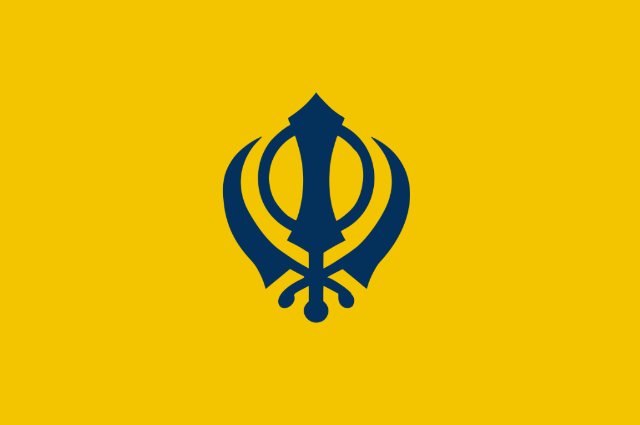Introduction
The Khalistan movement, a phenomenally intricate and multi-dimensional historical phenomenon, constitutes an amalgamation of fervent ethno-religious fervor, steadfast secessionist aspirations, and labyrinthine geopolitical intricacies.
The Genesis of Khalistan: A Historical Reverie
The etymological underpinnings of 'Khalistan' are deeply entrenched in the very foundations of Sikhism, an ascendant faith that found its roots in the fertile soil of the 15th century, flourishing amidst the overarching rule of the Mughal Empire over the Indian subcontinent. This resurgent religious fervor, meticulously orchestrated by the visionary Guru Gobind Singh, reached an epochal zenith in 1699 when it metamorphosed into the Khalsa. This evocative term, drawn from the Arabic language, resonated with the essence of unblemished purity. However, it represented more than a mere religious denomination; it embodied an intricate and far-reaching political vision. This vision was a masterstroke, a blueprint dedicated to protecting Sikhs and, by extension, safeguarding the diverse religious communities that found themselves vulnerable to persecution. Concurrently, this vision aspired to forge a sovereign Sikh state, one that would be the citadel of their faith and the epicenter of their cultural identity, firmly rooted in the hallowed soil of the Indian subcontinent.
Prelude to Partition: The Punjabi Suba Movement
The historical roots of the Khalistan movement are profoundly entwined with the tumultuous aftermath of the partition of the Indian subcontinent in 1947. This cataclysmic event, which resulted in the division of India into two nations, India and Pakistan, cast a long and complex shadow over the region. Within this historical turbulence, the precursor to the Khalistan movement, known as the Punjabi Suba movement, emerged as a fervent proponent of the creation of an autonomous Sikh state, where the Punjabi language would be the defining linguistic element. This movement, driven by a deep sense of Sikh identity, aspired to carve out a homeland where Sikhs could exercise greater autonomy and preserve their cultural and religious heritage.
However, the road to the realization of this dream was fraught with challenges. In a pivotal political juncture in 1952, India's then-Prime Minister Jawaharlal Nehru adopted a resolute stance against the establishment of an autonomous Punjabi-speaking Sikh state. His opposition exacerbated the simmering tensions between the Sikh and Hindu communities, engendering schisms and discord that would reverberate for years to come.
The denouement of this prelude unfolded in 1966 when the Indian government officially recognized the demand for a Punjabi-speaking state. It was at this juncture that the state of Punjab was formally carved out, with Chandigarh designated as its capital. This watershed moment in Indian history laid the groundwork for the tumultuous events that would subsequently unfurl, ultimately giving rise to the fiery resurgence of the Khalistan movement, which left an indelible mark on the socio-political landscape of the nation.
Resurgence and Turmoil: The 1970s and 1980s
The nascent years of the 1970s bore witness to the rekindling of the Khalistan movement among Sikhs in India, a resurgence that was ignited by the magnetic and charismatic Sikh leader, Jarnail Singh Bhindranwale. His leadership was characterized by a fiery and unwavering commitment to the cause of Sikh autonomy. Under his guidance, what had initially been a fervent political and cultural movement soon metamorphosed into a full-fledged armed insurgency, driven by a deep-seated belief that Sikhs were systematically marginalized and oppressed within the Indian state.
This armed insurgency marked a pivotal moment in the history of India. It implicated the Indian government in a complex and deeply entrenched conflict that would span years and leave an indelible mark on the nation's social fabric. The government's approach to dealing with this insurgency was fraught with challenges, as it had to navigate between ensuring national security and addressing the legitimate grievances of the Sikh community.
The cataclysmic year of 1984 stands as a poignant chapter in this tumultuous saga. In this year, Indian security forces, under the leadership of the then-Prime Minister Indira Gandhi, embarked on a military operation within the sacred precincts of the Golden Temple in Amritsar. This sacred site, the spiritual epicenter of Sikhism, had been commandeered as a stronghold by separatist forces, turning this hallowed sanctuary into a symbol of resistance against the Indian state.
Official government estimates place the tragic death toll of this operation at approximately 400 individuals, a figure that is deeply contested by Sikh groups and advocates. They contend that the actual number of lives lost far surpassed these official statistics, possibly numbering in the thousands. This glaring discrepancy in reported numbers remains a subject of vehement debate and contention, underscoring the deep wounds and mistrust that still persist.
Tragically, in that same year, the nation was shaken by another profound and grievous event. Prime Minister Indira Gandhi, who had authorized the military operation on the Golden Temple, met a grim and violent end at the hands of her Sikh bodyguards. This assassination acted as a cataclysmic catalyst, sparking a horrific and blood-soaked wave of anti-Sikh riots that swept through northern India, with New Delhi becoming the epicenter of this gruesome violence. Marauding Hindu mobs unleashed a brutal and tragic wave of violence, arson, and murder, leaving a devastating and indelible scar on the social fabric of the nation.
Flight 182 and International Implications
The turbulent aftermath of these epochal events reached its cataclysmic zenith with the tragic downing of Air India Flight 182 in 1985. The deliberate act of bombing that befell this transoceanic passenger aircraft, amidst the vast expanse of the Atlantic Ocean, exacted a heart-wrenching toll, claiming the lives of all 329 individuals aboard. This unprecedented act of terror unleashed a tempest of grief and consternation that reverberated across the globe.

Irish Naval Service personnel removing the body of a victim of Air India Flight 182 terrorist attack from the LÉ Aisling (P23) which was sent to search for survivors on 23 June 1985/Image by Wikipedia
A comprehensive and meticulous investigation, conducted in the aftermath of this heinous act, revealed that the orchestrators of this grim retribution were Canadian-based Sikh militants. This act, executed with chilling precision, was a retaliatory response to the military operation undertaken at the sacred precincts of the Golden Temple in Amritsar. It stood as a grim testament to the deep-seated grievances and indomitable resolve that fueled elements within the Sikh diaspora, rendering them willing to perpetrate such a grievous atrocity in their quest for retribution and justice.
Contemporary Contours: The Khalistan Movement in the Modern Epoch
In the contemporary epoch, the once fervid Khalistan movement has undergone a profound metamorphosis, transmuting into smoldering embers within the intricate political landscape of India. Predominantly nestled within the confines of the state of Punjab, where Sikhs constitute the majority demographic, this movement has witnessed a discernible wane in political patronage. Its relevance oscillates in a delicate dance, intricately synchronized with the ebb and flow of attention that the Indian government allocates to its presence.
Nonetheless, the Khalistan movement endures as a spectral presence, its remnants casting a long and haunting shadow within the global Sikh diaspora, notably in nations such as Canada, the United Kingdom, the United States, and Australia. In these far-flung corners of the world, the embers of this ethno-religious nationalism still flicker, fanned by the ardor of expatriate Sikhs who remain tethered to the dream of Khalistan, even as it faces a shifting and uncertain future within the ever-evolving tapestry of global politics and identity.
Global Sikh Diaspora
The global Sikh diaspora, constituting an indispensable and integral element in the perpetuation of Khalistan aspirations, encompasses an estimated 26 million individuals, as per estimations by the distinguished London School of Economics (LSE). Among these global hubs of Sikh communities, Canada boasts the most substantial Sikh population outside the Indian subcontinent, with approximately 770,000 adherents, as meticulously documented in the comprehensive 2021 census.
In alignment with the 2021 census in England and Wales, the United Kingdom provides a welcoming haven for approximately 524,000 Sikhs. Meanwhile, Australia, in conformity with its 2021 census, shelters a thriving congregation of around 210,000 Sikhs. The United States, despite the notable absence of a specific religious parameter within its census methodology, reputedly plays host to a Sikh community ranging from 200,000 to 500,000 individuals.
In recent years, a notable development has emerged in the form of Sikhs for Justice (SFJ), an organization that has undertaken the orchestration of unsanctioned referendums regarding the establishment of Khalistan in various countries. Notably, in Australia, the reverberations of such plebiscites have catalyzed confrontations between factions advocating for Khalistan and their counterparts from the Hindu community.
In response to this protracted confluence of events and mounting tensions, the Indian government has vehemently implored the governments of Canada, Australia, and the United Kingdom to institute legal actions against Sikh activists, particularly in the case of Canada, where Sikhs represent a formidable demographic, constituting nearly 2 percent of the country's population.
Recent Developments and Diplomatic Discord
In the aftermath of these recent geopolitical developments, Canadian Prime Minister Justin Trudeau has unabashedly cast aspersions upon India, levying weighty allegations of its covert involvement in the assassination of the prominent Sikh separatist leader, Hardeep Singh Nijjar. This accusatory rhetoric, imbued with grave implications, has ignited a perilous trajectory of escalating tensions between the Dominion of Canada and the Republic of India, precipitating a convoluted and protracted diplomatic imbroglio.
In a retaliatory gesture of reciprocal diplomacy, the Indian government, in a decisive act of reprisal, has opted to suspend the issuance of visas to Canadian citizens. The ostensible rationale behind this suspension hinges upon the asserted presence of 'security threats' that are purported to have insidiously permeated and disrupted the regular and unhindered functioning of its diplomatic missions meticulously stationed across the Canadian landscape. This suspension, laden with strategic implications, underscores the gravity of the prevailing situation and the countermeasures invoked by India in the face of perceived hostilities.
Furthermore, in a meticulously calibrated move of symmetrical retaliation, India has resorted to expelling a high-ranking Canadian diplomat, thereby mirroring Canada's expulsion of Pavan Kumar Rai, a senior and influential operative affiliated with India's foreign intelligence agency, who had been actively operating within the sovereign precincts of Canadian territory. This tit-for-tat maneuver serves as a tangible manifestation of the heightened tensions and underscores the reciprocity that often defines the realm of diplomatic engagements, particularly amid instances of strained intergovernmental relations.
Conclusion
The Khalistan movement, deeply enshrined within the intricate tapestry of South Asian historical narratives, occupies a pivotal and enduring role in the multifaceted mosaic of India's socio-political landscape. Its historical trajectory, marked by cycles of resurgence, subsequent decline, and transformative evolution over the decades, bears testament to the indomitable tenacity of ethno-religious nationalism. This fervent nationalist sentiment transcends the constraints of geographical boundaries and traverses the annals of various historical epochs, etching its presence as a distinctive and enduring facet of the Indian subcontinent's political and social milieu.
In the contemporary era, this phenomenon stands as a paradoxical testament to the intricate interplay of religious fervor, seismic political upheavals, and far-reaching international ramifications. The global Sikh diaspora, meticulously nestled within the historical narratives of countries such as Canada, the United Kingdom, Australia, and the United States, serves as a potent undercurrent in this modern-day paradigm. It acts as a formidable catalyst, engendering enduring discourse, generating diplomatic intricacies, and epitomizing the enduring complexities inherent in the interplay of cultural identity and political expression.

